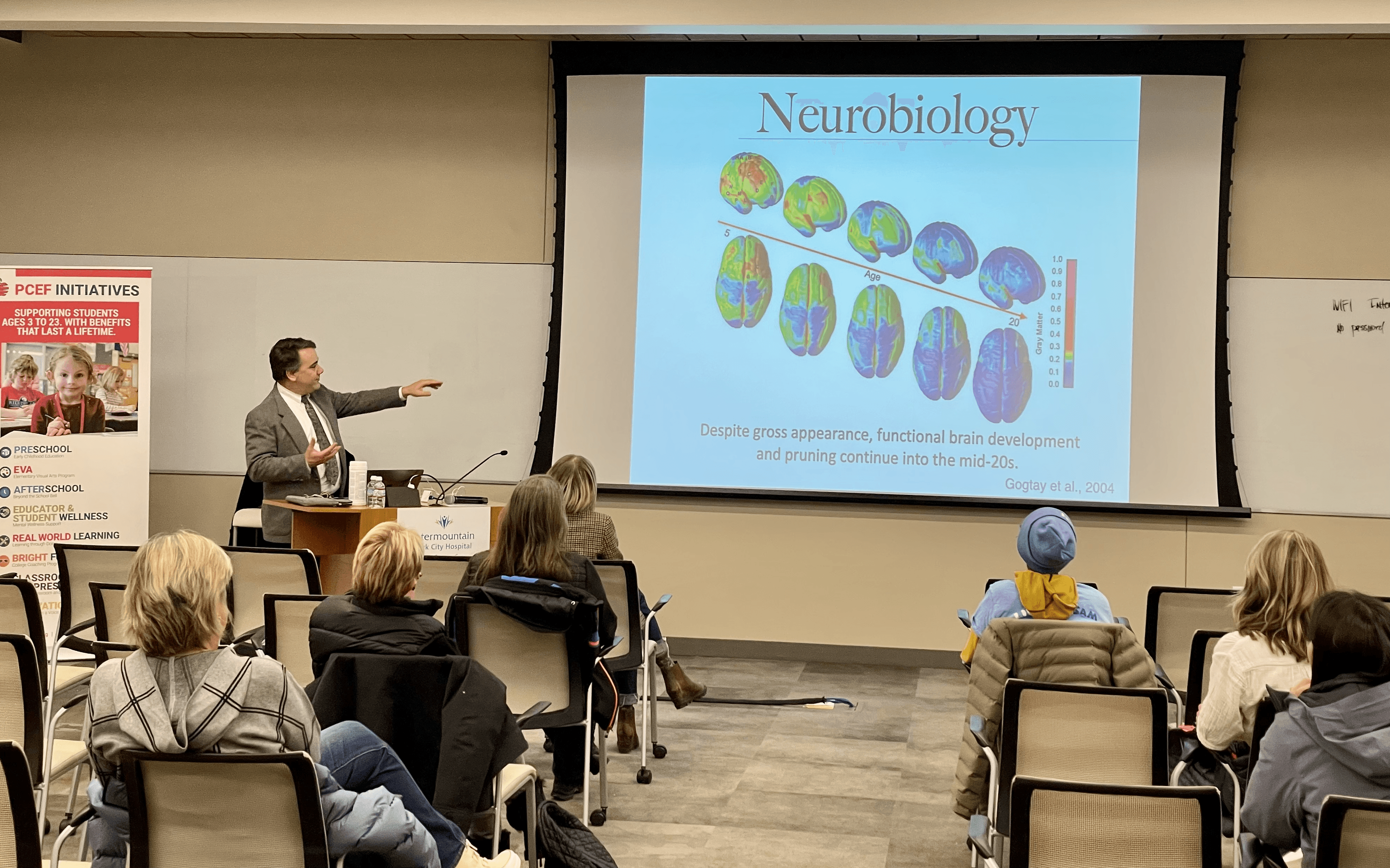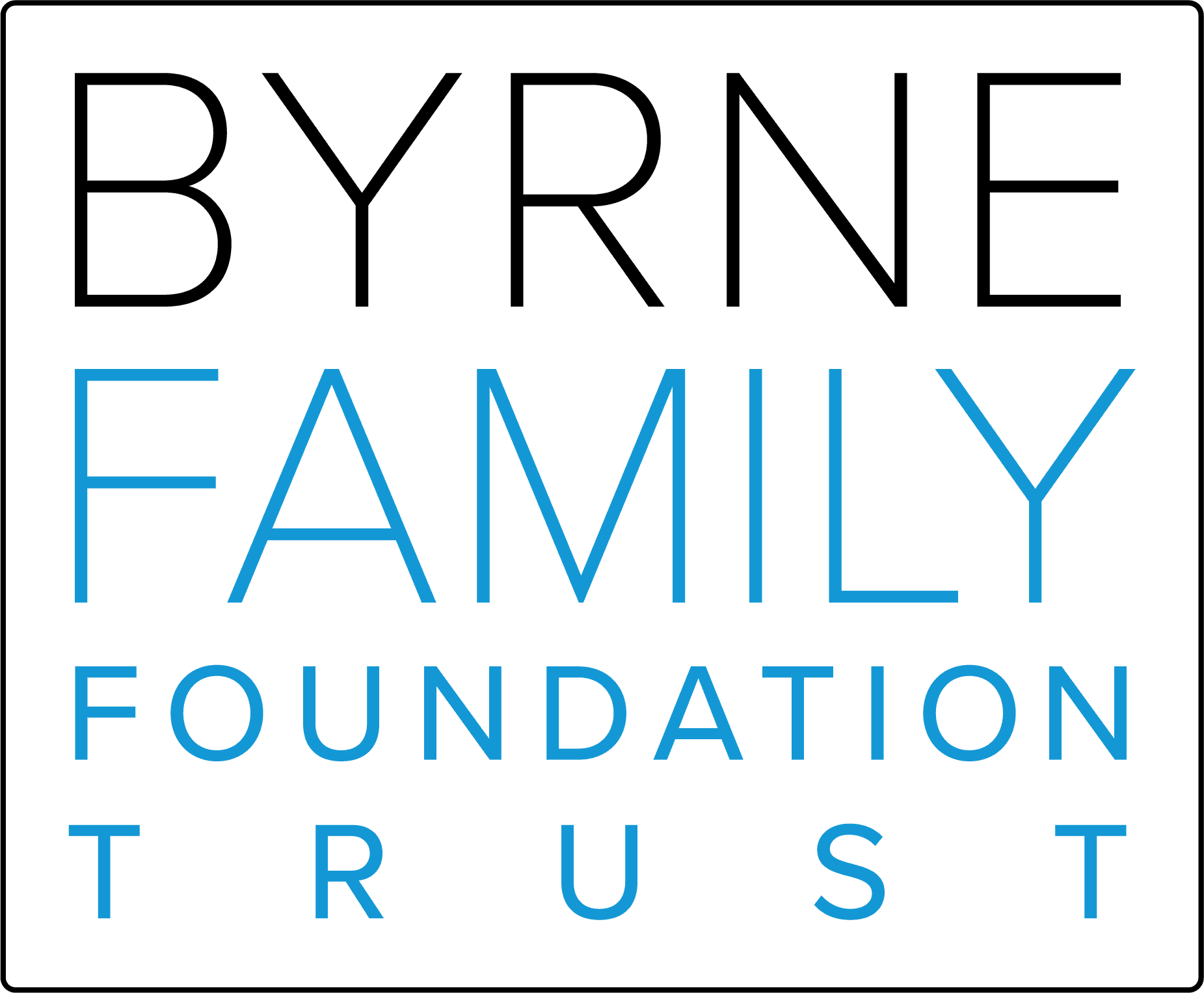
Dr. Jason Rafferty was the second speaker in Park City Education Foundation’s Educator and Student Wellness Speaker Series. The Series is a program of PCEF’s Educator and Student Wellness Initiative.
Thank you to Summit County Behavioral Health for partnering with us on this event.
The following is a recap of his presentation; credit for this content goes to Dr. Rafferty.
ADOLESCENCE: A CHALLENGING TIME FOR DECISIONS
- From a very young age, kids know how “rewards” feel.
- BUT - the prefrontal cortex - the “brakes” - takes longer to develop.
- The gap between risk awareness and rewards is biggest during adolescence.
- Plus, the reward itself in adolescence seems to be even more stimulating than it is for an adult.
So, not only are adolescents behind in goal-directed behavior, the “reward” is that much more appealing to them...
Additional challenges:
- Marketing efforts → E-cigarettes, marijuana, etc. are made to look like candy – which makes it look familiar and safe.
- Media reporting → thousands of stories have been done about the safety of substances like marijuana, battles for legalization, and so on. This creates a lot of mixed messaging for adolescents - who often only see headlines & aren’t differentiating their risks vs. risks for adults.
UNDERLYING REASONS FOR ADOLESCENT SUBSTANCE USE
Co-occurring mental illness is significant among adolescents/teens, and in many cases, it’s WHY they use/abuse.
“Young people aren’t accessing mental health treatment or getting resources they need, so in many cases they use these substances to help them feel better,” said Dr. Rafferty. “We always need to ask, what ‘s REALLY going on that we can support?”
Many times, kids cite boredom as the number one reason for substance use/abuse. There’s also lots of sadness and loneliness, and kids often say they are worried and depressed. Lots of times, these are also indicators of mental health challenges.
Also worth consideration - many teens use substances to relax and have a good time with friends - which may indicate that they may be socially awkward - perhaps neuro-divergent or experiencing social anxiety, etc.
If the teen is able to decrease usage - but doesn’t address mental illness, usage can come back and the substance abuse can occur again - and be worse.
SUBSTANCES TEENS ARE BEING EXPOSED TO/USING
An annual University of Michigan, Ann Arbor survey of 8th, 10th, and 12th graders indicates the following:
- Vaping/e-cigarettes (nicotine or marijuana) is most-used
- Vaping up more than 10x (since 2011) → in middle school AND high school
- Cigars are second-most-used
- Illicit drug use is steady - overall, those rates are traditionally very small
“I think this is a good thing,” Dr. Rafferty said. “Most of the stories you tend to hear about with illicit drugs and teens come from unintentional exposures - and these are generally more rare events.”
TEENS ARE LISTENING!
“This is important because everyone says teens don’t listen - this shows that they do!” - Dr. Rafferty
The Good
Over the years, as perceived harm of traditional cigarettes has gone up through lots of publicized resources, there is an overall decrease. Generally, as knowledge of a perceived risk goes up - usage goes down.
Alcohol usage (binge drinking) has also, over time, gone down.
The Bad
Marijuana is a different story. There is a lot of public health information around the dangers since the 1980s or so. BUT - since the 90s, there has been a lot of debate and discussion about legalization. As a result, we see usage is up and perceived risk is down.
Critical for adolescents:
The longer you delay usage - the less chance they have to develop dependence.
“If we can create some spacing - if we can push it out a little more,” said Dr. Rafferty, “We can really decrease long-term negative outcomes.”
The Ugly
Kids tend to have no idea what is in e-cigarettes. In one survey Dr. Rafferty cited, 66% did not think vaping exposed them to nicotine.
What teens believe is in e-cigarettes:
- 66% say JUST FLAVORING (no nicotine)
- 13% don’t know
- 13% say nicotine
Not only does it include nicotine, but vaping also exposes them to high amounts of formaldehyde - yes, that chemical used to preserve and plasticize corpses.
The bottom line:
Smoking/vaping ultimately damages DNA - which means cells are damaged and repair activity is reduced. This increases the risk of cancer and other serious diseases.
The Hope
Experimenting is a part of growing up - but, again, the later it happens, the lower the chance they develop deep, long-term dependency or usage.
Additionally, while the risk of death is relatively low through the age of 24, it jumps significantly at 25. We are trying to protect them in the long term.
BE AWARE OF THESE RISKS
Benzodiazepines → Things like Valium, Xanax, and others can be in medicine cabinets - if kids get their hands on them it can be very dangerous.
Dabbing → This isn’t the dance move. It’s weed wax: a highly concentrated form of marijuana, typically the color of honey, with a consistency like Jello or butter.
It’s a totally different ball game in terms of what it is doing to you.
- Dabbing is WAY more dangerous than traditional marijuana - it’s extremely strong and concentrated.
- Average THC content is 10–15%.
- Dabs contain THC concentrations up to 99% (!) which makes it way more likely to be habit-forming.
- As a result, bad side effects are much more common: things like hallucinations, paranoia, loss of consciousness, suicidality, and more are much more likely, among other concerns.
DELTA-8 THC → This psychoactive substance, despite being labeled “all-natural” is not found in significant amounts in the plant.
- Producers take a bunch of plants and concentrate them - with that comes SIGNIFICANT contamination concerns.
- Some manufactures may use unsafe household chemicals to make it and or unsanitary production conditions may exist.
- This substance is also not evaluated by the FDA for safety.
- Hundreds of adverse effects have been reported by the FDA and by National Poison Control centers.
- They include hallucinations, vomiting, tremors, anxiety, dizziness, confusion, and loss of consciousness.
Inhalants/Huffing → An increase in this abuse was reported when COVID hit and kids used whatever was around.
- The first huff CAN kill you - or the 10th - or the 100th.
- This has been declining overall - but again, COVID triggered a bump in usage.
Fake Pills → The number of [fake] pills containing fentanyl seized by law enforcement is going way up.
- It's REALLY hard to tell which pills are real and which are fake.
- Fake pills bring with them the risk of fentanyl (synthetic opioid) contamination.
- Fentanyl is 50x more potent than morphine.
ACTIONS YOU CAN TAKE: TALK TO YOUR CHILDREN
When To Talk
In slide after slide, a big jump in substance exposure/usages occurs between 8th grade and 10th grade. Conversations around substance exposure/use/abuse would be well-placed in this timeframe, and when they are about to go into high school is a very, very, very important time!
How To Talk
Dr. Rafferty addressed how to talk about substances using a Harvard Health blog called “Teens and drugs: 5 tips for talking with your kids.”
- Make your values and your rules clear… and be specific.
Don’t use vague statements like “be smart” - a teen may translate this to mean, be smart and don’t get caught…
- Ask and listen, but resist the urge to lecture… Teens who feel like their point of view is valued may be more willing to engage in a conversation.
A good way to get around is to ask questions and reflect back to them what they are saying - try to use “and” instead of “but.”
- In response to what your child says, use nonjudgmental reflective statements to make sure she feels listened to, then follow up with a question…
- If your child has used substances, try to explore the reasons - there may be underlying mental health issues that are not being addressed.
- Give praise & control your emotions - recognize things like, “they’re trying to be safe.” You can also say things lile, “let’s talk about where we can improve on that.”
Excessive anger and/or disappointment may cause your child to shut down and avoid any discussion in future.
- You don’t need to agree with everything your teen says; you just need to make it clear you are listening.
Know when (and how) to intervene. What are the local resources and help? Also, be mindful of any family history of substance use disorders. One of the biggest factors in long-term addiction development is its presence in the family.
You can also start talking about the things many teens DO care about to dissuade them from usage:
- Effect on weight and appetite
- Gynecomastia in young men
- Poor decision-making while intoxicated
- Decreased school performance
- Difficulty obtaining and keeping a job
ACTIONS YOU CAN TAKE: WHAT TO HAVE NEARBY
It’s always a good idea to have Narcan (naloxone HCI) at home. Think of it like a fire extinguisher: have it and hope you never, ever have to use it.
You can purchase these with an ID from any pharmacist. Dr. Rafferty says prescriptions can be obtained for them, but that those may potentially trigger health insurance increases; it may be more simple and less expensive to simply purchase from the pharmacy.
DO NOT keep them in your car - they are sensitive to temperature fluctuations.
This critical topic is certainly a tricky one, and it’s our hope that this information helps parents navigate.
There are many local resources which provide support, including Summit County Behavioral Health.
If you are having a crisis, call 801-587-3000 immediately.
To connect with your child’s school counselor(s):
PCEF’s Educator and Student Wellness Speaker Series
Dr. Jason Rafferty's talk, "Tripping through Adolescent Substance Abuse and Experimentation: What Parents Need to Know," took place Monday, December 5, 2022.
Jason Rafferty, MD, MPH, EdM
Dr. Rafferty, a Clinical Assistant Professor at the Warren Alpert Medical School of Brown University, is an attending psychiatrist and pediatrician specializing in the care of adolescents with substance use disorders in the VISTA intensive outpatient co-occurring disorders program at Bradley Hospital.
A Harvard Medical School graduate, Dr. Rafferty completed post-graduate training through the Triple Board Residency (Pediatrics, General Psychiatry, and Child/Adolescent Psychiatry) at Brown University. He has additional masters’ degrees from Harvard University in public health (MPH) concentrating on Maternal and Child Health, and education (EdM) focused on adolescent development and psychology.















